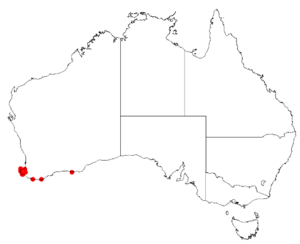Boronia anceps facts for kids
Quick facts for kids Boronia anceps |
|
|---|---|
| Conservation status | |
| Scientific classification | |
 |
|
| Occurrence data from Australasian Virtual Herbarium |
Boronia anceps is a plant in the citrus family, Rutaceae and is endemic to a small area in the south-west of Western Australia. It is a perennial herb with small leaves and pink, four-petalled flowers.
Description
Boronia anceps is a perennial herb that grows to a height of 60 cm (20 in), has flattened stems and lacks a lignotuber. Its leaves are narrow egg-shaped to narrow oblong about 20 mm (0.8 in) long although those near the top are very reduced. The flowers are pink or pinkish purple and are borne in a cyme on the tip of the stems. The groups of flowers are on a thin peduncle up to 60 mm (2 in) long, each flower on a thin pedicel 5–10 mm (0.2–0.4 in) long. The four sepals are dark red, narrow triangular to broadly egg-shaped and 2–4 mm (0.08–0.2 in) long. The four petals are broadly egg-shaped and about 8 mm (0.3 in) long with their bases overlapping. The style and stigma are continuous. Flowering occurs from September to December or January.
Taxonomy and naming
Boronia anceps was first formally described in 1998 by Paul G. Wilson and the description was published in Nuytsia from a specimen collected near a crossing on the Scott River near Augusta. The specific epithet (anceps) is a Latin word meaning "two-sided", referring to the shape of the stem.
Distribution and habitat
This boronia grows in seasonally swampy heath and is only known from between the Scott River and Walpole.
Conservation
Boronia anceps is classified as "Priority Two" by the Government of Western Australia Department of Parks and Wildlife meaning that it is poorly known and known from only a few locations but is not under imminent threat.


